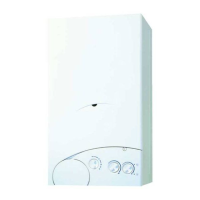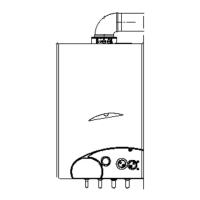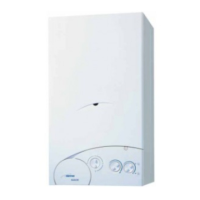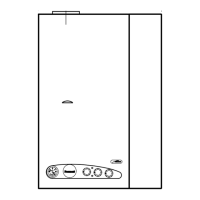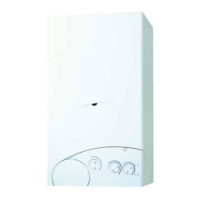If an electrical fault occurs on the appliance
the preliminary electrical system checks
must be carried out first.
When any service or replacement of elec-
trical components which has required the
breaking and re-making of electrical con-
nections has taken place, the following tests
must be repeated:
– earth continuity;
– short circuit;
– polarity;
– resistance to earth.
5.1 EARTH CONTINUITY CHECK
Appliances must be electrically disconnect-
ed, meter set on Ω (ohm) x 1 scale and
adjust zero if necessary. Tests leads from
any appliance earth point (e.g. inside control
box) see wiring diagrams (section 7) to
earth pin on plug.
Resistance should be less than 1 Ω (ohm). If
the resistance is greater than 1 Ω (ohm)
check all earth wires for continuity and all
contacts are clean and tight. If the resis-
tance to earth is still greater than 1 Ω
(ohm) then this should be investigated
futher.
5.2 SHORT CIRCUIT
CHECK
Switches turned FULL ON - meter set on Ω
(ohms) x 1 scale. Test leads from L to N on
appliance terminal block, if meter reads 0
then there is a short circuit.
Meter set on Ω (ohm) x 100 scale. Repeat
it with leads from L to E. If meter reads less
than infinity (∞) there is a fault.
NOTE: Should it be found that the fuse has
failed but no fault is indicated, a detailed
continuity check (i.e. by disconnecting and
checking each component) is required to
trace the faulty component.
It is possible that a fault could occur as a
result of local burning/arcing but no fault
could be found under test. However, a
detailed visual inspection should reveal
evidence of burning around the fault.
5.3 POLARITY CHECK
Appliance reconnected to mains supply and
meter set on 300 V ac scale. Test at appli-
ance terminal block.
– Test leads from L to N meter reads
approx.: 240 V ac.
– Test leads from L to E “ ” meter reads
approx. 240 V ac.
–
Test leads from N to E “ ” meter reads
from 0 to 15 V ac.
5.4 RESISTANCE TO
EARTH CHECK
Appliance must be disconnected from main
supply and meter on Ω (ohm) x 100 scale.
All switches including thermostat on test
leads from L to E - if meter reads other than
infinity (∞) there is a fault which should be
isolated.
A detailed continuity check is required to
trace the faulty component.
IMPORTANT:
These series of checks are the first elec-
trical checks to be carried out during a
fault finding procedure. On completion
of the service/fault finding task which
has required the breaking and remaking
of electrical connections then the
checks 5.1 Earth continuity, 5.3 Polarity
and 5.4 Resistance to earth must be
repeated.
5 FAULT FINDING
6.1 REMOVAL OF
BURNER ASSEMBLY
– Isolate from mains
– Remove case cover
– Isolate gas
– Drop down control case
– Remove ignition lead
– Disconnect gas pipe from gas valve to
burner mixing arm,
– Disconnect air sensing tube
– Remove air inlet to fan
– Remove 3 times screws holding arm to
main heat exchanger body
– Remove arm with fan attached
– Check seals and replace if necessary
– Draw out main burner
– Replace in reverse order
– Test for gas tightness
6.2 REMOVAL OF FAN UNIT
– Isolate from mains
– Remove case cover
– Isolate gas supply
– Drop down control cover
– Remove ignition lead
– Disconnect gas pipe from gas valve and
burner mixing arm
– Disconnect air sensing tube
– Remove air inlet to fan
– Unplug 2 x cables from fan
– Remove 3 times screws to main heat
exchanger body
– Remove arm with fan attached
– Check seals and replace if necessary
– Loosen 2 x 8mm bolts from fan and
remove 2
– Remove fan
– Remove restrictor plate and fit to new
fan
– Refit in reverse order
– Re commission boiler
– Test for gas tightness
6.3 HEATING THERMISTOR
(SM SENSOR)
– Remove case cover
– Unclip thermistor from flow pipe
– Disconnect cable
– Refit in reverse order
– Ensuring cables are vertical
6.5 SAFETY STAT
– Isolate from mains
– Remove case cover
– Pull clip forwards slide stat upwards
– Remove 2 black wires connected
– Apply heat sink compound to new stat
– Replace in reverse order
6.6 FLUE STAT
– Isolate from mains
– Remove case cover
– Loosen clip holding air intake tube to flue
hood and remove
– Unplug cable from stat
– Loosen stat using 15mm spanner and
remove
– Refit in reverse order
6.7 IGNITION ELECTRODE
– Isolate from mains
– Remove case cover
– Remove grommet from rear of PCB
board cover and unplug ignition lead
– Remove 2 x screws
– Pull electrode forward
– Replace in reverse order
– Ensure correct gap set
6.8 EXPANSION VESSEL
– Isolate from mains
– Remove case cover
– Isolate flow and return valves
6 REPLACEMENT OF PARTS
31
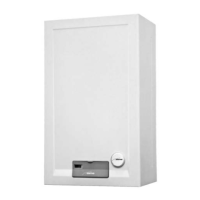
